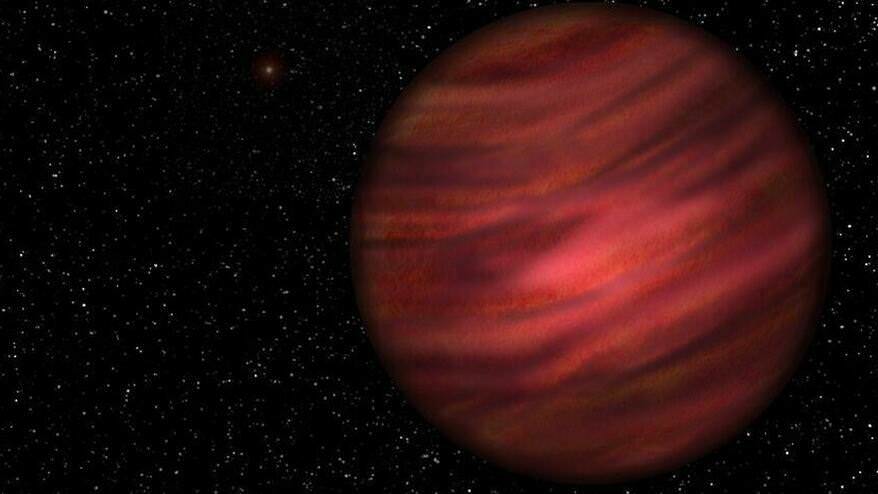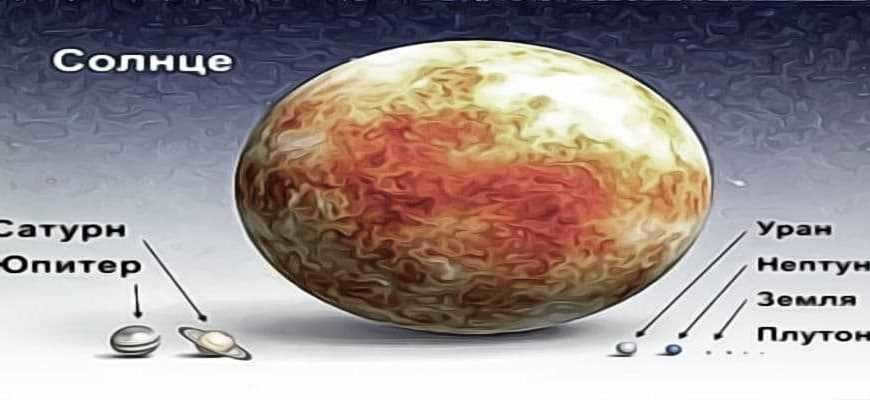
Our star system is an exceptional place. At the very least, it is the only place where life can be found. However, its marvels do not end there. So, what else is there to explore?
The largest celestial body in the star system
The largest celestial body within the star system, and the most colossal of them all, happens to be Jupiter. Its equatorial diameter measures 143,884 kilometers. This is a staggering 11,209 times the diameter of Earth and approximately 0.103 times the diameter of the Sun. In terms of volume, Jupiter is equivalent to 1,319 volumes of Earth. The mass of Jupiter is a staggering 318 times that of Earth, and it is 2.5 times the mass of all the other planets combined. It would take a whopping 1,047 planets similar to Jupiter to amass a mass equal to that of the Sun.
The equatorial size of the second largest planet, Saturn, is 0.84 times the size of Jupiter. Additionally, its mass is equivalent to 0.30 times the mass of the largest planet. Similar to Saturn, Jupiter was able to achieve its massive size due to its early formation in the solar system at a location that allowed for the accumulation of significant amounts of gas from the protoplanetary nebula.
The planet with the highest number of satellites
In the last ten years, numerous new moons have been detected in the vicinity of colossal celestial bodies such as Jupiter, Saturn, Uranus, and Neptune. As of October 1, 2019, Saturn holds the record for the most moons with a total of 82. Following closely behind is Jupiter, boasting 79 satellites. Uranus comes in third with 27 moons, while Neptune trails with 14. It is highly probable that all of these planets possess additional undiscovered miniature moons. The exact origin of these satellites remains a mystery, although it is widely believed that the larger moons of these massive gas planets formed simultaneously with their parent planets, while the smaller outer moons are believed to be captured asteroids.
Hottest planet
Venus holds the distinction of being the hottest planet in our solar system, with surface temperatures ranging from 460 to 480 °C. This scorching heat is primarily a result of the planet’s dense atmosphere, which is composed mostly of carbon dioxide. The atmosphere of Venus acts as a thermal insulating blanket, causing the average surface temperature to soar to 400 degrees above what it would be without an atmosphere. Despite the ability of solar heat to penetrate Venus’ clouds, the presence of carbon dioxide leads to the occurrence of a well-known phenomenon called the greenhouse effect.
The most brilliant planet in our solar system
Once again, Venus takes the title for being the most brilliant planet in our solar system, boasting a maximum stellar magnitude of -4.4. As the closest planet to Earth, Venus has the advantage of effectively reflecting sunlight due to its cloud-covered surface. In fact, the upper layers of Venus’ clouds reflect an impressive 76% of the sunlight that shines upon them.
Venus appears at its brightest when it is in the sickle phase as observed from Earth. This is because Venus’ orbit lies closer to the Sun compared to Earth’s orbit, resulting in the planet’s disk being fully illuminated only when it is on the opposite side of the Sun. During this time, Venus is also at its greatest distance from Earth, resulting in its apparent diameter being the smallest.
The tiniest planet in the solar system
Once upon a time, Pluto was acknowledged as the tiniest planet in our solar system. It was stumbled upon in 1930. With a mere diameter of 2400 kilometers, it pales in comparison to its planetary peers. It takes approximately 6.39 days for Pluto to complete one rotation on its axis. In terms of mass, it is a mere fraction of Earth’s, weighing in at 500 times lighter. Pluto also boasts a companion, known as Charon, which was discovered by J. Christie and R. Harrington in 1978. However, in the year 2006, Pluto’s planetary status was revoked, as it was demoted to the classification of a dwarf planet. Consequently, it was expelled from the esteemed group of regular planets, with Mercury stepping up to fill its vacant spot.
The planet with the strongest winds in the solar system.
Neptune holds the record for the highest wind speeds in the entire solar system. These extreme winds are observed in the equatorial region of the planet. Large-scale atmospheric formations move from east to west at a velocity of approximately 325 meters per second relative to the planet’s core, while smaller formations move at almost twice that speed. In fact, the wind speeds near Neptune’s equator reach near-supersonic levels.
Neptune’s atmosphere has a speed of sound of about 600 m/sec. Strong winds have been observed on all the gas giant planets, but it is still unclear why Neptune experiences the fastest atmospheric movement. It is possible that the planet’s internal heat sources play a role in this phenomenon. Saturn, on the other hand, is the second “windiest” planet, with maximum wind speeds approximately half as high as those on Neptune.
The most frigid location in the entire solar system
Among the various celestial bodies in the solar system, the lowest temperature ever registered on a surface was documented on Triton, one of Neptune’s moons. The Voyager 2 spacecraft conducted measurements that revealed this temperature to be an astonishing -235 °C. This is a mere 38 °C away from absolute zero. It is highly likely that Pluto’s surface temperature is very similar to these extreme conditions. However, at this time, we can only speculate based on estimations from Earth’s surface.
Based on these calculations, it is estimated that the illuminated regions of Pluto have an approximate temperature of -233 °C. The shaded areas, on the other hand, are approximately 20 °C warmer. Pluto and Triton exhibit remarkable similarities: their resemblance surpasses that of any other pair of celestial bodies in the entire solar system. The surface temperature of planets and moons is determined by various factors including their distance from the Sun, the presence of internal heat sources, and the influence of the atmosphere. Both Triton and Pluto receive minimal heat from the Sun, and they lack any internal sources of heat, resulting in extremely cold conditions. This constant evaporation of ice from their surfaces contributes to their frigid nature.
The Biggest Moon
Ganymede, the satellite of Jupiter, holds the title of the largest moon in the solar system. With a diameter of 5,262 kilometers, it surpasses all other moons. Titan, Saturn’s largest moon, comes in second place with a diameter of 5150 km. It was previously believed that Titan was larger than Ganymede, but recent measurements have proven otherwise. In third place is Callisto, another satellite of Jupiter, which is also larger than the planet Mercury (with a diameter of 4878 km). Ganymede’s distinction as the “largest moon” is due to its thick icy mantle that envelops its rocky core.
Smallest satellite
The tiniest moon with a precisely known size is Hippocampus, Neptune’s satellite. It measures approximately 8 kilometers in diameter. Leda, one of Jupiter’s moons, may potentially challenge Deimos as it has an estimated diameter of about 10 kilometers. Determining the size of other small moons that orbit the outer planets is challenging since they can only be observed as point objects. Estimations of their size rely on the chosen value for the reflectivity of their surface.
Estimates indicate that some recently discovered moons of Jupiter and Saturn have diameters measuring just a few kilometers. It is believed that Deimos, along with Mars’ other moon, Phobos, and many of the new moons orbiting the gas giants, were originally asteroids that were captured by the planets. Both of Mars’ moons have surfaces that are extremely dark, reflecting only a small percentage of the sunlight that reaches them. These moons bear a resemblance to the asteroids commonly found in the outer regions of the asteroid belt and in the Trojan group, which consists of asteroids associated with Jupiter. Additionally, there is a possibility that Leda is an asteroid that was captured by Jupiter and subsequently placed into orbit around the planet.
The highest volcano in the entire solar system
Shield volcanoes on Mars claim the title of the highest volcanoes in the solar system, and at the pinnacle of this group is Mount Olympus. Towering above the surrounding plateau, its summit reaches a staggering height of 25 km. In addition, the sheer magnitude of its base spans almost 550 km. By comparison, the Hawaiian Islands on our own planet only manage to rise a mere 10 km above the seabed. Shield volcanoes gradually build up their height over time through a series of eruptions from the same volcanic vent. However, on Mars, these volcanic formations are on a much grander scale than their counterparts on Earth. So, what exactly is the reason behind this remarkable disparity?
Despite the fact that Mars volcanoes are currently inactive, it is likely that they formed before those on Earth and have remained active for a much longer period. However, volcanic hotspots on Earth have shifted their positions over time due to the gradual movement of tectonic plates. As a result, there has not been enough time to construct exceptionally tall volcanoes on Earth. Additionally, the lower gravity on Mars enables erupted material from its interior to form much taller structures that do not collapse under their own weight.
The most observed comet
The comet 2P/Encke is the most frequently observed comet due to its proximity to the Sun. Unlike other comets, it never travels farther than 4 astronomical units from the Sun and remains just outside the asteroid belt. Thanks to modern observational techniques, we are able to continuously monitor this comet. What makes 2P/Encke particularly interesting is its unique orbit, with a period of only 3.3 years, shorter than any other periodic comet. The comet was independently discovered by Pierre Mechene in 1786, Caroline Herschel in 1795, and Jean Louis Pons in 1805 and 1818. However, it was not until 1819 that Johann Enke realized all these observations were of the same comet and calculated its orbit.
Halley’s Comet, also known as 1P/Halley’s Comet, has been observed as far back as 239 B.C. Its historical record surpasses that of any other periodic comet. Halley’s Comet stands out due to its unique characteristics. It has been observed a total of 30 times over a span of more than two thousand years. This is primarily due to its larger size and higher level of activity compared to other periodic comets.
The comet got its name from Edmund Halley, who in 1705 made the discovery that connected several of its previous sightings and predicted its reappearance in 1758-59. In 1986, the Giotto spacecraft successfully captured images of Halley’s Comet’s core from a distance of just 10,000 kilometers. The core was measured to be 15 kilometers in length and 8 kilometers in width. When the comet’s core is heated by the Sun, it creates a coma and tail, as gas and dust are released through the icy nucleus’s outer layer.
The most luminous comet
According to the available historical records, it proves to be challenging to ascertain which comet observed in the past exhibited the greatest brightness. Given that comets are elongated celestial bodies, precisely measuring their luminosity becomes nearly unattainable. The perception of a particular comet is highly subjective, varying according to the length of its tail and the darkness of the sky during the observation.
The most notable comets of the 20th century include the renowned “Great Daylight Comet” (1910), Halley’s Comet (during its appearance in 1910), the comets Schellerup-Maristani (1927), Bennett (1970), Vesta (1976), and Hale-Bopp (1997). The most remarkable comets of the 19th century are likely the Great Comets of 1811, 1861, and 1882. Prior to that, highly luminous comets were observed in 1743, 1577, 1471, and 1402. The closest and brightest sighting of Halley’s Comet occurred in 837.
The Nearest Encounter of a Comet with Earth
Out of all the documented encounters of comets, the one that came closest to Earth was Lexel’s comet in 1770. This remarkable event occurred on July 1, 1770, when the comet reached a distance of 0.015 astronomical units (equivalent to 2.244 million kilometers) from our planet. To put it into perspective, this distance is six times greater than the average distance between Earth and the Moon. At its closest approach, the size of Lexel’s comet’s coma appeared to be almost five times the diameter of a full Moon.
When studying astronomy either in school or independently, at some point we all become curious about the largest entity in the Solar System, its characteristics, and its identity. To uncover the answers to these timeless inquiries, it is crucial to have a clear understanding of the celestial bodies that comprise the solar system.
Celestial bodies that make up the solar system
The solar system consists of various celestial bodies:
- The Sun;
- The eight main planets and their moons;
- Dwarf planets;
- Asteroids;
- Comets.
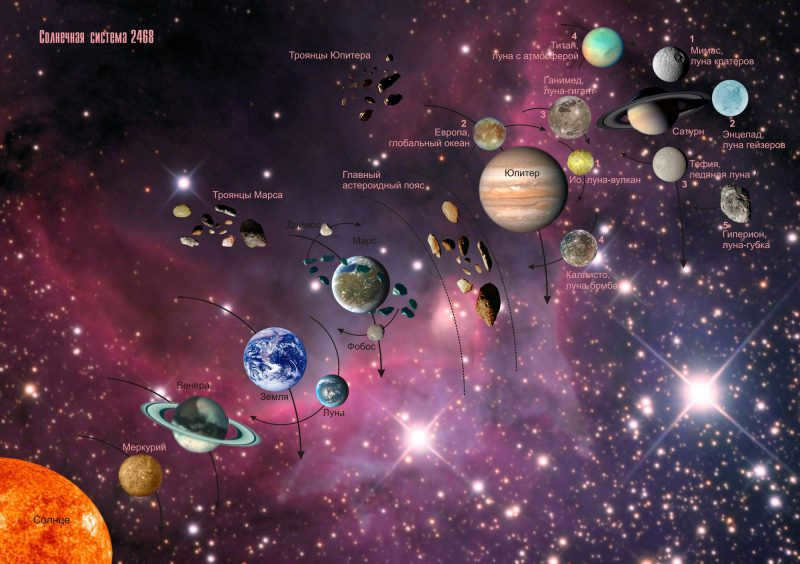
Celestial bodies within the solar system
The solar system is incredibly vast, spanning a distance of 12 billion kilometers. To simplify calculations, scientists utilize alternative units of measurement such as light years and astronomical units.
In recent years, numerous transneptunian objects have been discovered, although their size is challenging to accurately determine due to their significant distances.
The cosmos is home to several record-breaking celestial bodies boasting truly impressive dimensions. These celestial bodies have been recognized as the largest in the solar system.
The largest star in our solar system
Within our solar system, there exists a solitary star of truly remarkable dimensions – the Sun. With a diameter measuring a staggering 1,392,000 kilometers, it outmatches the Earth’s diameter by a factor of 109. Although scientists have hypothesized the presence of a satellite orbiting this colossal star, concrete evidence has yet to be discovered.
The Sun serves as the central figure in the realm of outer space. As a radiant, scorching-hot star, it takes on the shape of a perfect sphere. Notably, it shines brighter than any other star visible from our planet. Moreover, it is this celestial luminary that has had a profound impact on the origin of life on Earth. As such, this luminous star played a pivotal role in the formation of the galaxy’s primary celestial bodies. Furthermore, it fosters the unique conditions necessary for the development of planets and all forms of life on our planet.
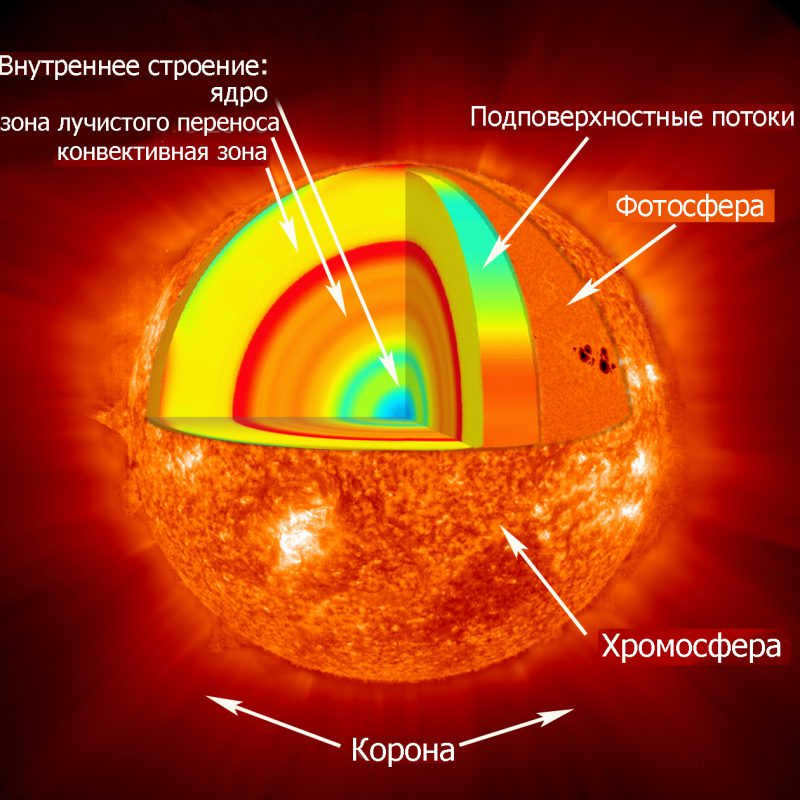
During recent years, the star’s brightness has increased, when compared to its earlier stages of development. It is now 70% brighter than what is visible from Earth today. The star is composed of many metals, which are heavier than hydrogen and helium. In contrast, older stars have very few metals. Astrologers argue that the Sun’s high metallicity has had a positive impact on the formation of our planetary system.
The most enormous planet in the entirety of the Universe
Jupiter is typically referred to as the “giant” or “giant” planet in outer space. This planet astonishes with its vastness, as its numerical value for diameter measures a staggering 143 thousand kilometers (which is 11 times greater than the circumference of Earth). The immensity of this “giant” is so immense that it is challenging to fathom. To put it into perspective, its mass index is 2.5 times the combined value of all the other planets.
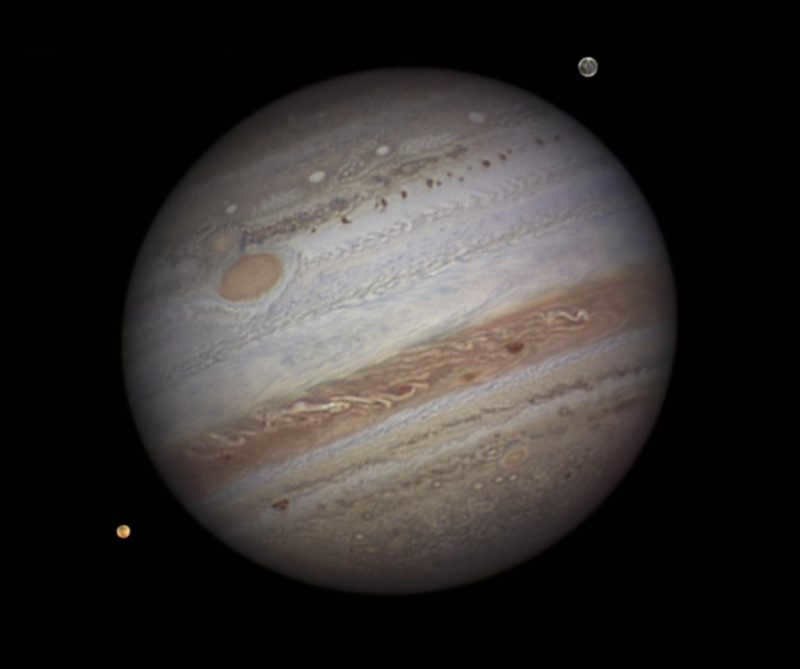
Satellite picture of the largest planet in our solar system – Jupiter
Interesting facts about Jupiter:
- Jupiter was named after a Roman god, and its moons were named after the god’s favorites and loved ones.
- Pioneer 10 was the first spacecraft to approach Jupiter at the closest distance.
- Although Venus and the Moon are brighter, Jupiter shines brightly enough to outshine Sirius in good weather.
- Jupiter has the most powerful magnetic field among celestial bodies, which is generated by the movement of hydrogen within the planet.
- Jupiter is a strong source of radio waves and can disrupt any spacecraft that comes close to it.
- Despite its massive weight, Jupiter is known for its astonishing speed. It only takes 10 hours for this celestial body to complete a full rotation around its axis. In comparison, it would take 12 years for Jupiter to orbit the largest star. This fascinating fact can be attributed to the influence of radiation and a powerful magnetic field on its rotation.
- Jupiter is adorned with 4 rings, and a recent discovery unveiled a fifth ring that is closest to the planet. This newfound ring has been named Halo.
One of the most notable features on Jupiter is the Great Red Spot, a massive hurricane-anticyclone that was first observed by an astronomer in 1665. This swirling storm stretches an impressive 40,000 kilometers in length. However, in present times, the scale of the anticyclone has diminished to 20,000 kilometers.
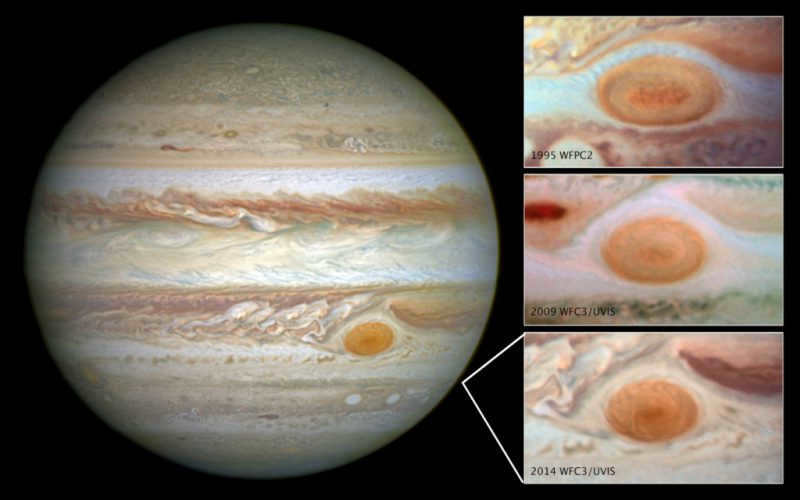
On Jupiter, there is a vortex that stands out as the largest and most massive in the entire solar system. The vortex, located in the upper atmosphere of the planet, is a bright spot that can be seen from space. It is hard to grasp the true size of this atmospheric anomaly without a frame of reference, but it can be said that the diameter of the vortex is three times that of the Earth. What makes this vortex even more fascinating is its unusual rotation – it spirals in the opposite direction with a speed of 435 kilometers per hour. Images of this massive vortex have been captured in 1995, 2009, and 2014, providing a glimpse into the mesmerizing world of Jupiter’s atmosphere.
Ganymede is unique among the other moons of Jupiter in our solar system. Its diameter measures 5,268 kilometers, making it larger than Mercury, Pluto, and several dwarf planets (when comparing average ellipsoids). If Ganymede were orbiting the brightest star, it would be classified as a full-fledged planet.
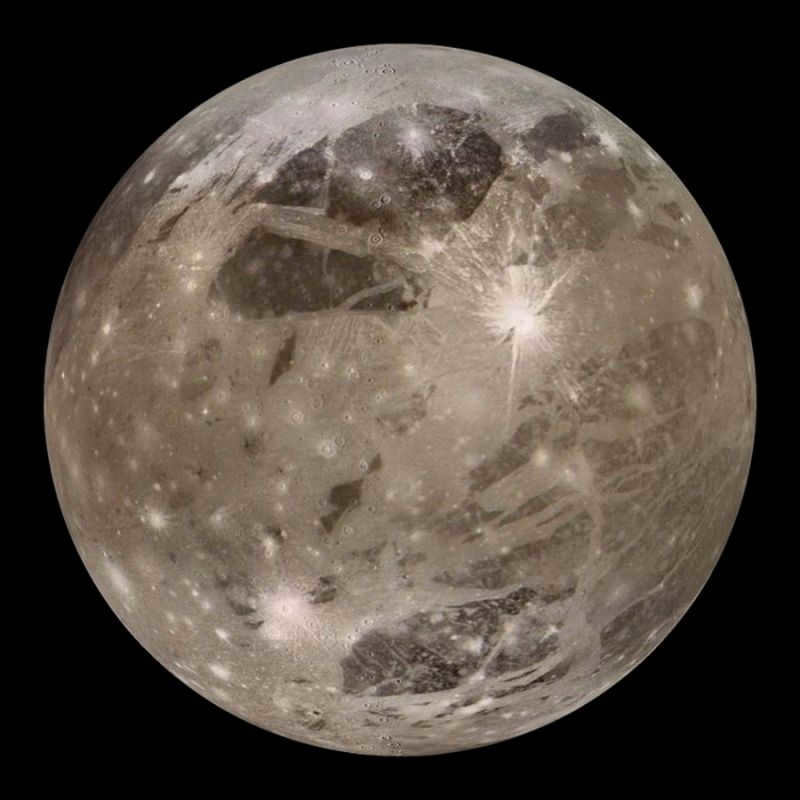
At first, scientists stated that Titan, the largest moon of Saturn, was the biggest satellite. However, it was later revealed that its apparent size is due to its dense atmosphere.
In May 2012, the European Space Agency announced its plan to launch a mission called the Jupiter Icy Moons Explorer in 10 years (2022), with the goal of reaching Jupiter by 2030. The primary objective of this mission is to conduct various studies on Ganymede, one of Jupiter’s moons, which will commence in 2033.
The Russian Federation aims to keep up with the European Space Agency and intends to send a spacecraft that will land on Ganymede. The mission’s purpose is to search for signs of life and living organisms, carry out diverse studies, and perform subsequent calculations.
The mountain on Mars, known as Olympus, is widely recognized as the largest in the entire universe due to its staggering height of 27 kilometers above the planet’s surface. This colossal structure is actually an ancient volcano that has long been dormant. To put its immense size into perspective, Olympus is three times taller than Mount Everest, the highest peak on Earth, and an astounding 2.6 times higher than Mauna Kea, a prominent mountain in Hawaii that extends from its base to the ocean floor.
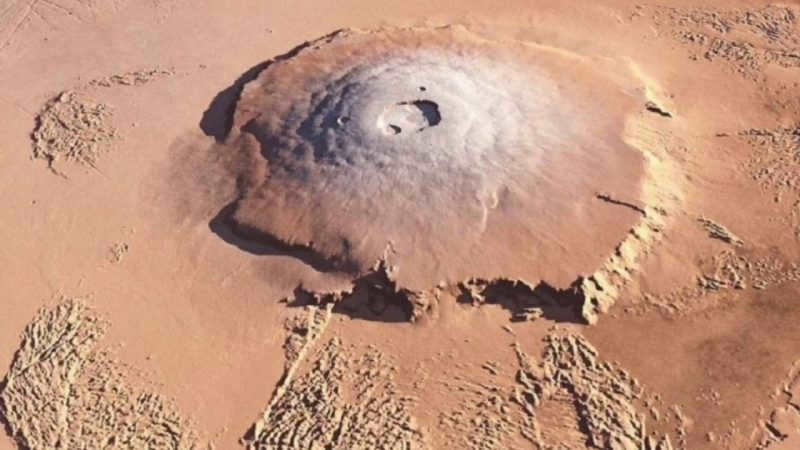
Mount Olympus, a volcano, holds the record for being the tallest peak in the entire universe.
According to scientists, Olympus reaches such astounding heights because the tectonic plates on Mars remain motionless. The mountain’s surface is composed of magma, which erupts and cools over billions of light years, gradually forming the mountain. It is no surprise that Olympus is hailed as the most massive and potent volcano in the cosmos.
The biggest crater is Eitken
The Moon has the largest crater in the universe. It is named the South Pole Basin – Eitken. The size of the celestial object is 2.5 thousand kilometers in diameter. It is situated on the far side of the Moon, and only the mountainous rim can be seen from Earth and satellites.
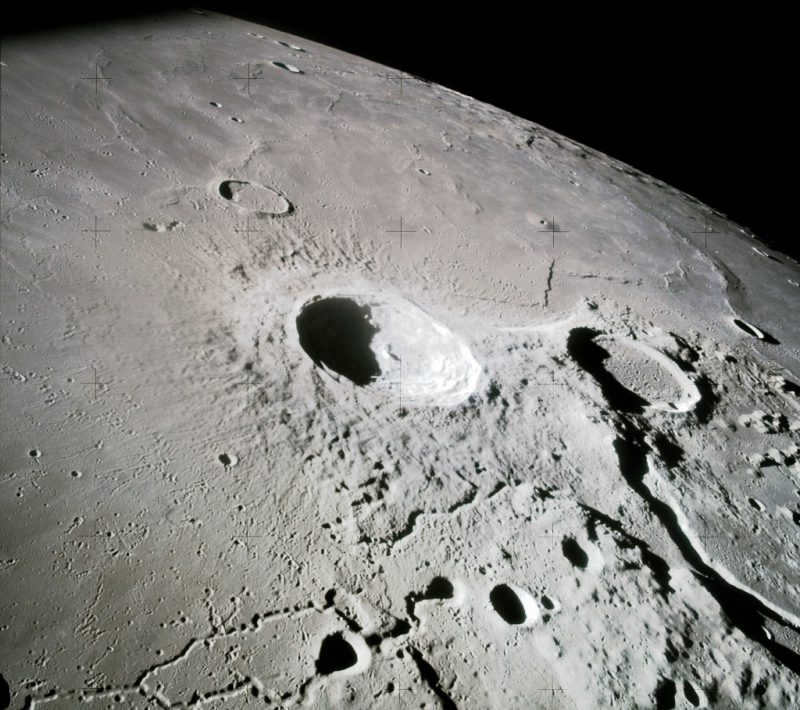
It was only through the use of the initial spacecraft to orbit the Moon that it became apparent that this is indeed the largest-sized crater. Astronomers remain uncertain whether Aitken is the largest crater in space, as they anticipate the discovery of additional craters on the surface of the planet Mars.
A celestial object as large as the Sun: a comet that caught astronomers’ attention in 2007.
Although the Sun is the largest star in the solar system, a remarkable discovery was made in 2007 when a comet of similar dimensions was observed. This extraordinary celestial body had an enormous coma, composed of dust and ice particles, which almost engulfed the massive star.
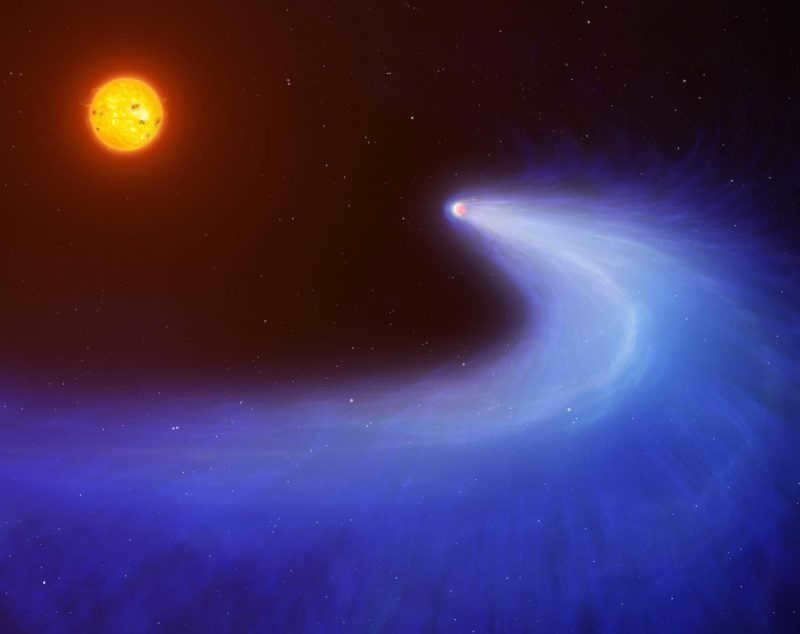
Comet and the sun: an astonishing scale
Discovered in 1892 and designated as 17P/Holmes, this comet remained out of sight for nearly six decades, from 1906 to 1964. However, in October 2007, the luminosity of this celestial object surged by nearly half a million times, creating the most intense burst visible to the naked eye. As November progressed, the comet continued to expand, reaching a diameter larger than that of the Sun.
Scientists Discover Another Unrecognized Planet in the Solar System
A team of scientists from the California Institute of Technology has made an extraordinary discovery: a new planet located beyond the orbit of Pluto. Despite its significant presence, this planet has not yet been officially recognized and remains unnamed. If confirmed, it would become the 9th planet in our solar system. Based on the research and observations conducted so far, here are the key characteristics of this enigmatic celestial body:
- Mass: The planet’s mass is approximately 10 times that of Earth, making it a significant heavyweight.
- Properties: Similar to Neptune, this new planet is also a gaseous entity, further intriguing scientists.
- Orbital Period: It takes approximately 15,000 years for this planet to complete one orbit around the Sun, highlighting its long journey through space.
- Orbit: The planet’s orbit deviates from the plane of Earth’s orbit, displaying an elongated and tilted trajectory.
- Origin: The exact origin of this celestial body remains unknown. However, experts in the field of astrology theorize that it is around 4.5 billion years old and was possibly ejected from a planetary disk near the Sun.
Tracking the unknown planet with a telescope is currently impossible, which makes it difficult to pinpoint its exact location. Scientists are instead relying on indirect evidence to support the existence of a celestial body in the Kuiper belt, although they have yet to reach a consensus.
When compared to our own Earth, this planet surpasses it in both size (by a factor of 1310) and mass (by a factor of 318). Astrophysicists speculate that Jupiter’s incredibly powerful magnetic field, which is 20,000 times stronger than Earth’s, is a result of a dense inner core of unknown composition, surrounded by a layer of liquid metallic hydrogen. The planet’s atmosphere is primarily composed of molecular hydrogen.
- When Galileo Galilei observed Jupiter through a telescope, he noticed the presence of four massive celestial bodies orbiting around it. These celestial bodies were later named “Galileo’s” in tribute to the discoverer. It’s almost like a miniature solar system!
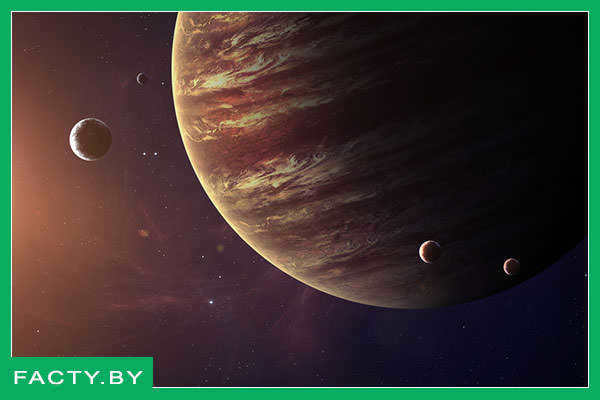
- As of 2018, there have been officially registered 79 satellites, but the precise number remains unknown. Scientists estimate that Jupiter has a minimum of 100 satellites.
- Ganymede is one of the largest known satellites. It is one of four celestial bodies that orbit the largest planet in our solar system. With a diameter of 3273.38 miles (5 thousand kilometers), its size surpasses that of Mercury.
- Europa revolves around Jupiter. It was first discovered in 1610. Beneath its immense layer of ice, it conceals a 100-kilometer-deep ocean, twice the size of Earth’s oceans.
Fun fact: our planet Earth acts as a guardian in the solar system, being the largest planet. Its strong gravitational force attracts asteroids and meteorites, preventing them from causing harm to humanity.
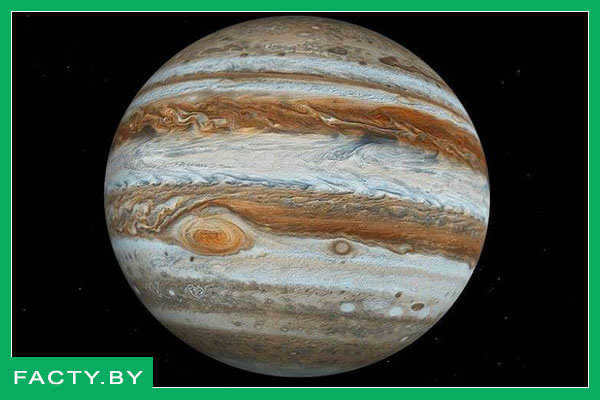
While our knowledge continues to expand, our exploration of the cosmos remains an ongoing adventure. The article titled "Fascinating Insights into the Solar System’s Largest Planet" has concluded. Our planet is a magnificent place, and we have only scratched the surface of what lies beyond in the vastness of the universe. Countless astronomical discoveries await us in the future.
Recommended articles
Save or share this article using the buttons below
- You are currently browsing:
- Home
- Planets
- The largest planet in the solar system and interesting facts about it
The knowledge we have about planets is limited, giving us only a basic understanding of these celestial objects. Much of the information is still unknown or unconfirmed, existing only as hypotheses. Each planet in our solar system is vastly different from Earth, requiring some effort to comprehend their unique characteristics.
The most well-liked
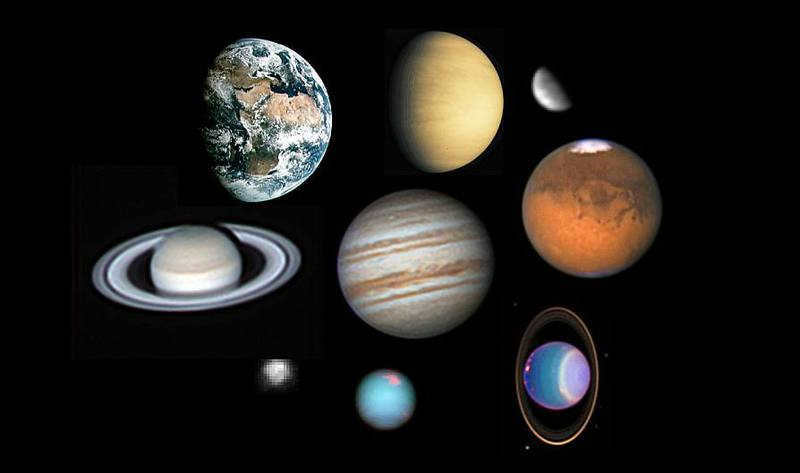
Among the celestial bodies of the solar system, there are some truly colossal giants. Taking the lead in this ranking is Jupiter, with a diameter measuring a staggering 139,822 km and a mass surpassing that of our planet by a factor of 317.8. Following closely behind is Saturn, with a diameter of 116,300 km.
When determining the largest celestial body in the solar system (excluding the Sun), it is crucial to consider their fundamental physical characteristics. Size and weight are the key factors in this assessment.
Specifically, the largest planet in the solar system outweighs our Earth by a staggering 300 times in terms of mass, and its diameter is a remarkable 11 times longer. To gain insight into the ranking of the five colossal bodies orbiting the Sun, refer to the following list.
5th place. Earth
The Earth is ranked fifth in the list.
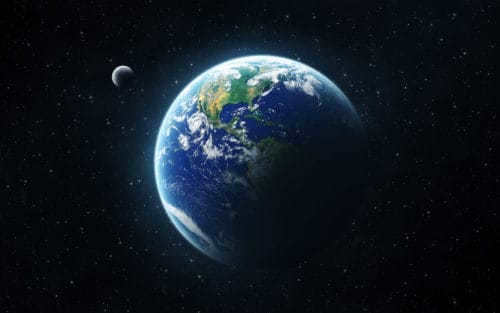
Earth is the largest planet in the solar system out of all those that belong to the Earth group. It orbits at a precise distance from the sun, positioned at an ideal distance and angle to sustain life. A slight deviation would result in freezing water, like on distant planets, or vaporization, like on Venus or Mercury.
- Diameter: 12,742 kilometers.
- Equatorial radius: 6,378 kilometers.
- Polar radius: 6,356 km.
- Land area: 148,940 thousand km, 2.29.2%.
- Sea area: 361,132 thousand km, 2.70.8%.
Earth has only one orbiting satellite, the Moon, which revolves around Earth and completes one orbit in 27.3 days.
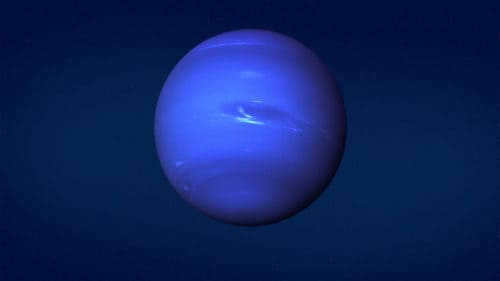
It is often humorously referred to as “the smallest of the giant planets”. This nickname stems from the fact that Neptune, while classified as a giant planet, is only 3.8 times larger in diameter than Earth.
After Pluto was reclassified as a dwarf planet, Neptune claimed the title of being the farthest planet from the Sun. Interestingly, despite its position, Neptune has a higher average temperature than Uranus due to its chemical composition.
Although Neptune’s surface area and volume are smaller than Uranus, it is actually heavier. This is due to the abundance of ice and rocks on Neptune, which contribute to its overall mass.
- The diameter of Neptune is approximately 49,224 kilometers.
- Its equatorial radius is around 24,700 km.
- The polar radius measures about 24,300 km.
- Neptune’s mass is approximately 17.1 times that of Earth.
The planet known as the “tiniest giant” has a total of 14 moons, with Triton being the standout in terms of size.
Coming in third is Uranus
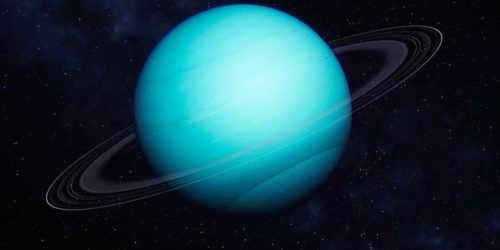
Uranus, the third largest planet in terms of area in the Solar System, holds the title for being the coldest. Despite being closer to the Sun than Neptune, Uranus is much colder, with temperatures reaching as low as -224 °С.
This frigid temperature can be attributed to the chemical composition of Uranus, particularly the absence of metallic hydrogen within the planet. Its atmosphere primarily consists of hydrogen and helium, with traces of methane. Although it ranks third in size, Uranus only takes the fourth spot when it comes to weight.
- Uranus has a diameter of 50,724 kilometers.
- It is 14.5 times heavier than our planet.
- The equatorial radius measures 25,550 kilometers.
- The polar radius measures 25,000 kilometers.
Uranus is surrounded by a total of 27 moons. The most prominent one is called Titania, which measures around 789 km in radius.
Coming in second is Saturn
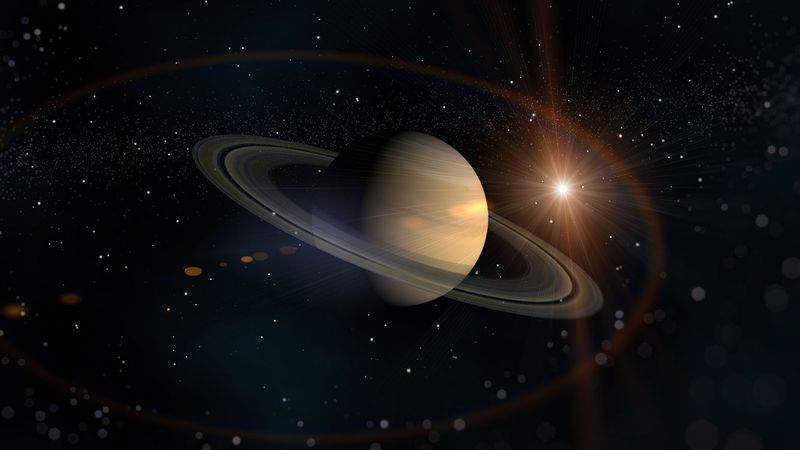
Saturn, the second largest planet in our solar system, is known for its iconic rings. These rings can be observed even with a small amateur telescope. The composition of this massive celestial body is primarily gaseous, consisting of a combination of various chemical elements.
Deep within Saturn lies its core, which is composed of iron, nickel, and ice, all of which are covered by a layer of metallic hydrogen.
- With a diameter of 116,300 kilometers, Saturn is a truly colossal planet.
- Its equatorial radius measures 60,300 kilometers.
- Meanwhile, its polar radius is 54,400 kilometers.
In addition to being the second largest planet in our solar system, Saturn also holds the record for the highest number of satellites. With a total of 62 moons, Saturn’s most famous satellite is Titan. Titan’s mass is an astounding 95.2 times that of Earth.
The Cassini interplanetary station was employed to investigate the giant, Jupiter. It was utilized to examine the rings of Saturn, as well as the composition of Jupiter’s atmosphere and magnetosphere.
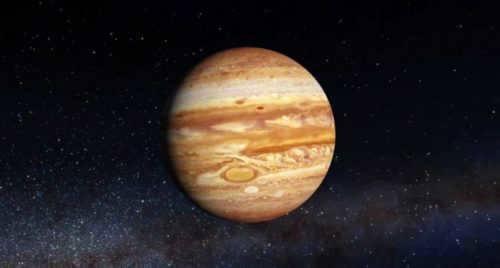
Jupiter is at the top of this list because it measures 139,822 km in diameter. Being the biggest planet in our solar system, it is a gas giant like its smaller counterparts. The outer layer of the planet is comprised of various gases and has a temperature range of 140-150 °C. Numerous substances have been identified within this layer:
In the gas shell of Jupiter lies a layer of extremely hot metallic hydrogen, reaching temperatures of several thousand degrees. The core of the planet is believed to be rocky in nature.
Jupiter’s mass is nearly 2.5 times that of all the other planets in the solar system combined. It is 317.8 times heavier than Earth, but about 1,000 times lighter than the Sun. The surface density of Jupiter is calculated to be 6.21796 *1,010 km 2.
Jupiter currently boasts a total of 79 satellites. Among these, the four largest were first observed by the Italian astronomer-physicist Galileo in 1610.
Just like Saturn, Jupiter also possesses a set of rings. However, these rings are not visible from Earth due to the planet’s great distance, relatively small size, and the density of particles within the rings. The existence of Jupiter’s rings was confirmed in 1979 by a NASA spacecraft. The investigation revealed that the ring system of this giant planet is made up of three distinct components:
- The inner layer, known as the halo.
- The main ring, which is more easily observed.
- The outer ring, often referred to as the “spider” ring.
The inner ring, or halo, extends from the central portion of the rings up to the top of Jupiter’s clouds. Its expansion is a result of the influence of Jupiter’s magnetic field. The main ring is flattened in shape, approximately 30 km thick and with a width of 6,400 km. The inner ring is transparent and has been likened to a “spider web”.
Video
Exploring the enigmatic realm of the Jupiter system:

